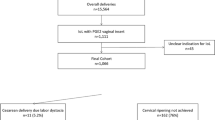Abstract
Objectives
To identify whether electively induced labor places the mother or her fetus at an increased risk as compared to her spontaneous labor cohort. To quantify the risk of cesarean section in the induced group.
Methods
A prospective analysis comparing 200 electively induced parturients with 200 matched controls who labored spontaneously, in 1 year from April 2007 to April 2008. The parturients were between 37 and 41 weeks of gestation and had no complications necessitating induction.
Results
Induction per se was not associated with a statistically significant increase in cesarean section rates. Only when associated with nulliparity, low bishop score, and birth weight >3.5 kg, the risk of cesarean increases.
Conclusion
Elective induction does not appear to pose an increased risk to the mother or her fetus in a carefully selected patient population. However, when associated with risk factors the cesarean rate increases. Hence informed consent should be taken before induction.
Similar content being viewed by others
References
Macer JA, Macer CL, Chan LS. Elective induction versus spontaneous labor: a retrospective study of complications and outcome. Am J Obstet Gynecol. 1992;166:1690–7.
Vrouenraets FPJM, Roumen FJME, Dehing CJG, et al. Bishop score and risk of cesarean delivery after induction of labor in mulliparous women. Obstet Gynecol. 2005;105:690–7.
Prysak M, Castronova FC. Elective induction versus spontaneous labor a case control analysis of safety and efficacy. Obstet Gynecol. 1998;92:47–52.
Smith LP, Nagourney BA, McLean FH, et al. Hazards and benefits of elective induction of labor. Am J Obstet Gynecol. 1984;148:579–85.
Vahratian A, Zhang J, Troendle JF, et al. Labor progression and risk of cesarean delivery in electively induced nulliparas. Obstet Gynecol. 2005;105:698–704.
Maslow AS, Sweeny AMYL. Elective induction of labor as a risk factor for cesarean delivery among low risk women at term. Obstet Gynecol. 2000;95:917–22.
Author information
Authors and Affiliations
Corresponding author
Rights and permissions
About this article
Cite this article
Ramasamy, V., Thunga, S. & Nayak, S.R. Is Elective Induction Safe? A Prospective Analysis. J Obstet Gynecol India 61, 667–669 (2011). https://doi.org/10.1007/s13224-011-0109-5
Received:
Accepted:
Published:
Issue Date:
DOI: https://doi.org/10.1007/s13224-011-0109-5



